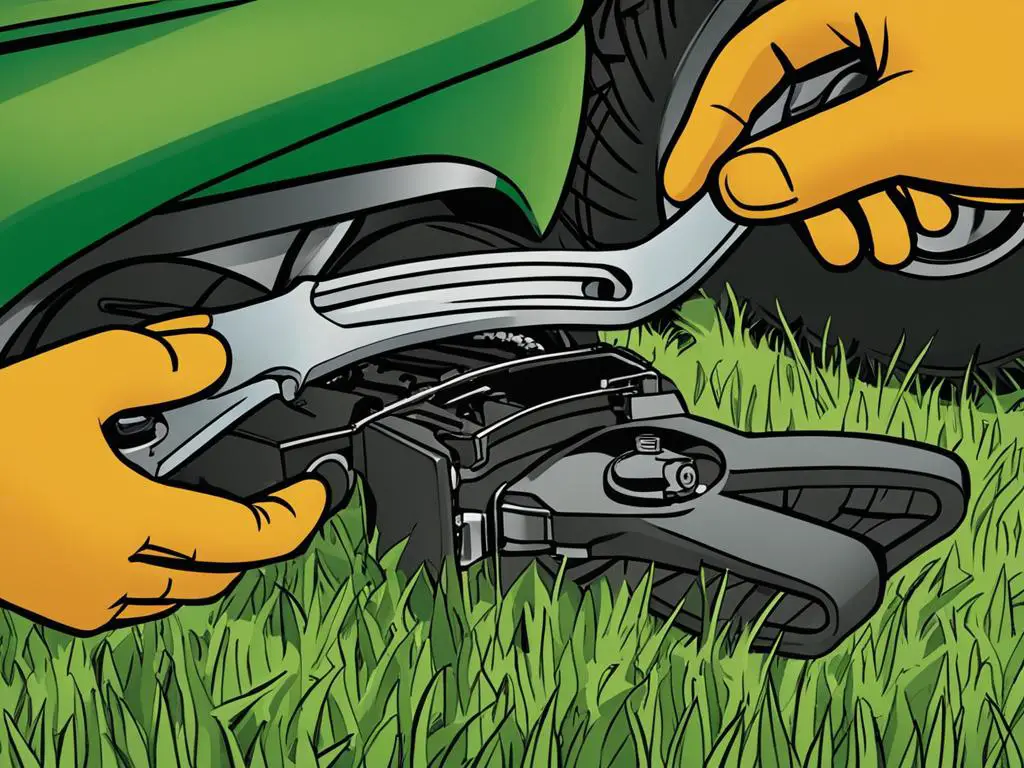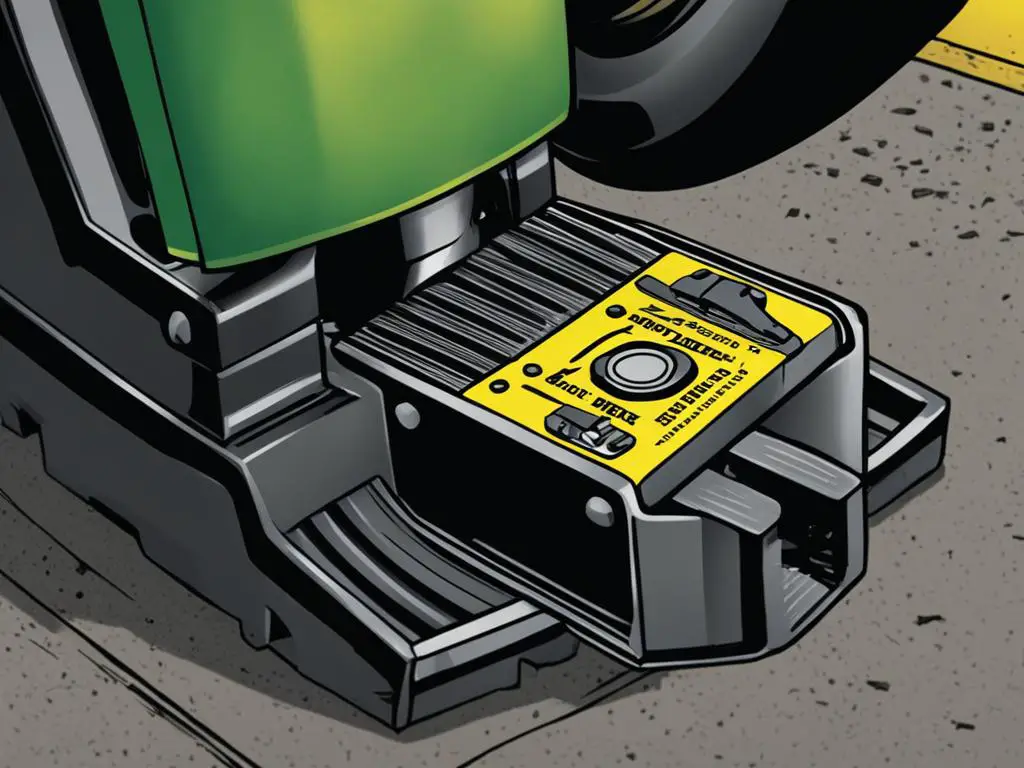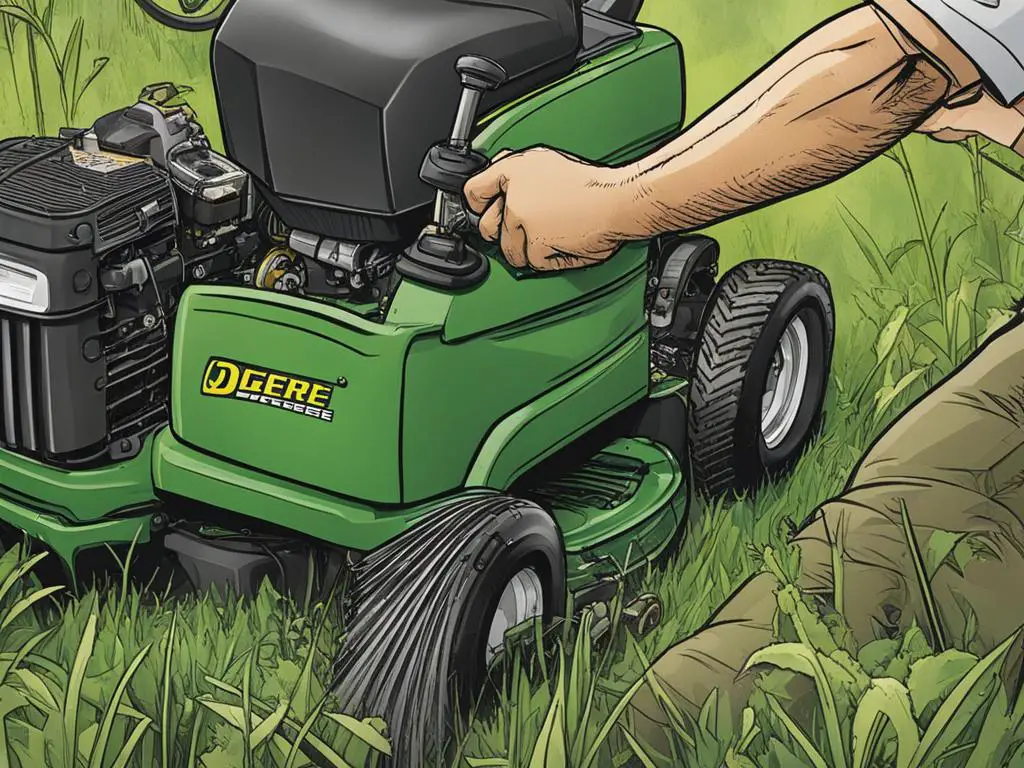If you’re faced with the challenge of a John Deere riding mower that’s stationary, despite your promptings to plow forward or reverse, you understand the setback it can cause to your lawn care routine. You’re not alone in confronting this vexing issue, and there are a number of potential culprits to consider. From transmission failure to drive belt repair, each problem requires a systematic approach to diagnose and solve. This article is dedicated to guiding you through the intricacies of John Deere riding mower troubleshooting, providing you with comprehensive brake system fixes, wading through mower electrical issues, and offering viable fuel system solutions. Armed with these insights, you can return to the seamless operation of your vital lawn care equipment, ensuring that your mower cuts a swath through the grass rather than settling into it.
Let’s get into the nuts and bolts of what makes your John Deere mower tick, or rather, what prevents it from ticking. From the transmission’s inner workings to the finesse required for a well-tuned fuel system; we’ll go under the hood to bring clarity to these complex mechanisms. Whether you’re a DIY enthusiast ready to tackle mower maladies or seeking knowledge before seeking professional help, our guide will equip you with the essentials for thorough equipment maintenance. By addressing these issues promptly and correctly, you can stave off further complications and ensure the longevity of your John Deere riding mower.
Key Takeaways
- Decode the different issues causing immobility in your John Deere riding mower.
- Learn how to tackle transmission failure with targeted repairs and maintenance.
- Understand the signs of a failing drive belt and the steps for effective drive belt repair.
- Discover the best practices for diagnosing and fixing brake system issues that can impede mower motion.
- Gain insights into resolving mower electrical issues that may halt operational capacity.
- Find solutions to common fuel system problems for a smoother running mower.
- Emphasize ongoing lawn care equipment maintenance to prevent future breakdowns.
Understanding the Basics of John Deere Transmission Issues
When your John Deere mower refuses to engage in forward or reverse motion, it’s often a transmission problem that needs your attention. Several mower transmission signs could point towards this issue. For instance, you might experience gear shifting problems where the mower becomes recalcitrant during changes in speed or direction. Another alarming symptom could be the unexpected appearance of fuel leakage near the transmission—a clear indicator that all is not well.
Distinctive transmission noise, such as a grinding sound in the mower, is a tell-tale signal of potential problems within the transmission’s inner workings. Similarly, if your mower starts jerking during gear shift or ends up stopping abruptly while the engine is running, it’s likely you’re dealing with transmission faults. These issues often stem from a litany of internal transmission components in need of inspection or repair.

Behind these symptoms are common causes like worn-out gears or bearings, signaling extensive wear or damage. Alternatively, electrical malfunctions due to faulty sensors or compromised wiring can disrupt the transmission’s normal operation. The lifeblood of the system, the transmission fluid, could also be culpable, especially if it’s old, contaminated, or not at the required level, leading to transmission fluid issues.
To address these transmission woes, consider the following solutions:
- Thoroughly inspect internal parts for wear and tear—it may be necessary to replace damaged gears or bearings if they are found to be the culprits.
- Examine the mower’s electrical components, especially the sensors and wiring harnesses, to ensure they are intact and functioning correctly.
- Regularly check and maintain the transmission fluid. If it appears contaminated or degraded, a complete flush and replacement might be in order.
- Consult the John Deere user manual or a professional for guidance on troubleshooting transmission pumps and other intricate parts of the system.
Understanding these basics of transmission care and maintenance can dramatically increase the lifespan of your mower and guarantee a reliable performance throughout its years of service.
Identifying Common Causes of Drive Belt Failure in John Deere Mowers
When your lawn becomes an unwelcome jungle because your John Deere mower simply won’t move, it’s time to delve into the intricacies of mower drive belt issues. The drive belt, a crucial component in your mower’s anatomy, often takes the blame for mower operational hiccups. From seemingly innocuous jerking mower movements to an outright cessation of function, the symptoms of a compromised belt are unmistakable. But what leads to these disruptions? Let’s explore.
Often, drive system debris will stealthily accumulate, impeding the mower’s seamless glide across your lawn. This can result in debris entanglement around the drive belt, leading to undue stress and potential belt damage. Not to be ignored are the ravages of time—yes, age-related wear and tear upon the belt are all too common and can wreak havoc on its physical integrity.
Another prevalent cause for concern lies in the realm of belt tension adjustment. An improperly tensioned belt can either cause too much friction, leading to premature wear, or it could be too loose, resulting in slippage and inadequate power transmission. Both scenarios are not conducive to a well-functioning mower.
The remedy for such a situation involves a series of methodical steps:
- First, ensure your personal safety by disengaging the mower’s spark plug to prevent accidental ignition.
- With the user manual in hand, pinpoint the exact location and routing of the drive belt specific to your John Deere model.
- Proceed to inspect the drive system, vigilantly clearing out any detritus that would impose undue stress on the belt.
- Next, scrutinize the belt for signs of deterioration or damage. If an issue is detected, damaged belt replacement becomes a necessity.
- Adjust the tension of the belt in accordance with recommendations provided in the user manual, ensuring it’s neither too tight nor too lax.
If, after following these steps, you find the task of drive belt repair daunting or if the mower’s ailments suggest a complexity beyond a simple fix, seeking professional aid is sound advice. A qualified technician or John Deere service center can offer a thorough assessment and the expertise needed for a precise and enduring resolution.
Regular maintenance, including vigilant observation for early signs of belt wear and proper tensioning, can prevent such problems from occurring in the first place. By doing so, you can ensure your John Deere mower remains a reliable ally in the battle against an overgrown lawn.

Brake System Malfunctions: A Culprit for Immobility
Overcoming a stuck brake pedal and related John Deere brake problems is essential for restoring movement to your riding mower. These brake issues can make the difference between a mower that powers through your lawn and one that refuses to budge.
Stuck Pedals and the Impact on Movement
One common issue causing a stationary mower are unresponsive brake pads. Whether it’s due to foreign objects in the brake system or a simple case of neglect, it can often be resolved with some attention to detail. Clearing away any debris is typically the first step to freeing up a pedal that’s stuck, be it from a small stone or built-up dirt.
Hydraulic Issues Leading to Braking Challenges
A spongy brake pedal indicates a potential problem within the hydraulic system. The looming question might involve hydraulic system fluid pressure, whether it’s due to brake line leakage or a need for hydraulic pressure adjustment. Moreover, a seized brake caliper could also contribute to stiffness in the pedal, thereby preventing motion. Addressing these hydraulic issues efficiently may require flushing the brake fluid or repairing faulty brake lines.
If the braking system issues remain mysterious or formidable after your initial check, it’s advisable to seek expert diagnosis. Sometimes, these problems stem from complex internal defects that demand a professional’s experience and tools.

Diagnosing Electrical System Faults That Halt Operation
When it comes to maintaining a healthy and efficient John Deere mower, understanding the intricacies of mower electrical system issues is paramount. Symptoms such as an engine that refuses to start or a mower that’s unresponsive could signal dead battery symptoms or even a faulty ignition switch. It’s essential to navigate through the process of electrical component troubleshooting to prevent these hiccups from turning into full-blown operational failures.
Conscientious mower owners know that a regular battery check should be on any maintenance checklist. Still, in the instance of faltering performance, a battery replacement might be your first line of defense. Additionally, signs that a deeper electrical ailment exists could be more obscure and require a comprehensive diagnostic approach to isolate and rectify. To aid in this, we’ve assembled a guide to help identify and resolve typical electrical system malfunctions.
Below is a helpful table detailing the common symptoms, potential causes, and recommended actions when confronting electrical problems with your John Deere mower:
| Symptoms | Potential Causes | Recommended Actions |
|---|---|---|
| Mower will not start | Dead battery, Faulty ignition switch | Test battery voltage, Replace battery if necessary, Check and replace ignition switch if needed |
| Electrical components not functioning | Blown fuses, Faulty wiring | Inspect fuses and replace, Troubleshoot wiring and repair or replace |
| Weak or intermittent power delivery | Loose electrical connections, Corroded terminals | Tighten connections, Clean or replace corroded terminals |
| Complete loss of power during operation | Failed alternator, Bad battery cells | Test alternator output, Perform load test on battery, Replace faulty components |
Embarking on the task of resolving mower electrical issues can be as simple as a routine battery replacement, or it may involve the dissection of your mower’s wiring to locate a faulty ignition switch. While some troubleshooting can be conducted with confidence by those possessing a practical understanding of automotive electrical systems, enlisting the skills of a qualified repair technician is often the safest and most effective strategy for complex or unknown challenges.
Moreover, regular maintenance and proper storage habits can reduce instances of dead batteries and other preventable electrical system issues. By giving attention to these electrical components before they fail, you secure the lifespan and reliability of your John Deere mower and ensure your grasp on effortless lawn care remains firm.
John Deere won’t move forward or reverse: Troubleshooting Fuel System Complications
Finding your John Deere immobilized can often be attributed to fuel system complications. Addressing John Deere fuel issues promptly can mean the difference between a temporary hiccup and a full-fledged repair job. Owners may overlook the importance of the fuel quality, but old or stale fuel can adversely impact performance and even prevent the mower from starting.
Contributing to these fuel woes can also be a carburetor failure, which is critical for combining air and fuel in the perfect ratio for combustion. Irregular engine behavior or difficulty starting may signal the need for a carburetor inspection or replacement.
Engaging in regular engine tune-up maintenance goes a long way in preventing fuel system issues. This could include tasks such as air filter replacement, which ensures that clean air is provided to the mixture, vital for efficient engine operation. Neglecting such maintenance can lead to a range of problems, from decreased engine power to increased fuel consumption and emissions.
Another angle to consider when diagnosing a stationary mower is the hydraulic fuel system. Hydraulic fuel leak detection can be critical, as leaks can cause a decrease in fluid pressure, leading to sluggish or jerky movements. Signs such as unexpected oil spills or the smell of burning oil are clear indicators that a leak may be present.
To effectively handle these scenarios, here’s a concise action plan:
- For stale fuel, drain the old fuel from the system and refill with fresh fuel.
- Inspect the carburetor for signs of accumulation or damage. Replacement or professional servicing might be needed for resolution.
- Regular tune-ups should include checks and replacements of the air filter to ensure engine longevity.
- If a hydraulic fuel leak is suspected, verify the integrity of gaskets, seals, and the crankcase, and replace any defective parts.
In essence, a keen eye on your mower’s fuel system health is an intrinsic part of responsible mower ownership. By staying vigilant on these fronts, you can sidestep major inconveniences and keep your John Deere running smoothly across your property’s expanse.
Conclusion
Embarking on the repair journey of your John Deere riding mower can be a complex venture, but armed with a comprehensive John Deere mower repair guide, even the most intricate issues become surmountable. Understanding and addressing the quintessential areas such as the transmission, drive belt, brakes, electrical systems, and fuel delivery can profoundly impact the operability of your mower. This guide illuminated the pivotal steps and preventive measures to maintaining these crucial system components. Vigilance in detecting early signs of wear and undertaking routine checks are instrumental in preventing mower breakdowns.
Incorporating efficient lawn care practices into your maintenance routine not only ensures the seamless functioning of your machinery, but also contributes to a pristine lawn. The advice provided here serves as a preventive shield, designed to protect and prolong the performance of your riding mower through meticulous care and maintenance. Yet, sometimes the intricacies of mechanical issues extend beyond the reach of individual expertise, prompting the need for professional intervention. Utilizing expert services when the situation calls for it is a prudent step towards maximizing mower lifespan and securing your investment.
In conclusion, our shared expeditions into the heart of riding mower maintenance reveal a clear path to sustaining and enhancing the capability of your John Deere. With the right care and occasional help from skilled technicians, you can ensure continuous and efficient operation. Here’s to uninterrupted lawn care experiences and the long-lived service of your trusted John Deere, the stalwart keeper of well-manicured landscapes.
FAQ
What are the common signs of transmission failure in a John Deere riding mower?
Common signs include difficulty in gear shifting, fuel leakage, grinding sounds, jerking or sudden stopping during operation. These may indicate worn internal transmission components and contaminated transmission fluid.
How can I troubleshoot drive belt issues on my John Deere mower?
Look for symptoms like abnormal noises or jerking movements which could point to a faulty drive belt. Check for debris, wear and tear, or improper belt tension, and consult your user manual for specific repair guidance.
What should I do if my John Deere mower’s brake pedal is stuck?
Inspect for and remove any foreign objects that may be causing the pedal to stick. If the issue persists, it might be a hydraulic problem. Check for fluid pressure issues or leaks, a spongy pedal, or a seizure in the brake caliper.
Why is my John Deere riding mower having electrical system issues?
Possible causes include a dead battery, which could come from electronics left on without engine power, or a faulty ignition switch. Troubleshooting should start with checking these components and possibly consulting a technician if the problem is unclear.
How can I fix fuel system problems in my John Deere mower?
Start by ensuring you’re using fresh fuel. Check and clean or replace the carburetor if necessary. Regular engine tune-ups, air filter changes, and checking for any hydraulic fuel leaks are also important steps to take.
What preventive maintenance can I do to avoid mower breakdowns and ensure efficient lawn care?
Regularly check your mower’s transmission fluid, maintain belt tension, clean the brake system, ensure electrical components are functioning, and perform engine tune-ups. These steps will help prevent common issues and extend the lifespan of your lawn care equipment.


Leave a Reply